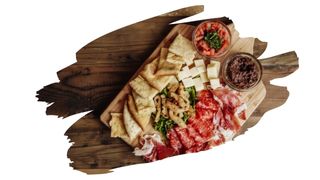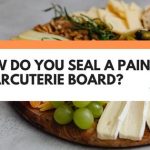The best way to seal and protect wood is to wrap it up in a waterproof sealant.
But not all types of wood sealers are safe enough to come into direct contact with your food — even if they’re a ‘food-safe’ finish such as polyurethane.
So, in this post, you will learn why food safe does not mean safe for direct food contact. And keep reading to find out which food grade wood finish is the best finish for your charcuterie board.

This post may contain affiliate links to products that we receive a commission for (at no additional cost to you). Learn more here.
Is There A Food Safe Polyurethane You Can Put On A Charcuterie Board?
Well, arguably, polyurethane finishes are food safe. But only after they’ve wholly dried and cured into a solid coat.
Nevertheless, double check the label of your particular polyurethane product to be sure.
However, polyurethane isn’t a great finish for a charcuterie boards. Why? Well, because charcuterie boards are a wooden surface that have direct contact with food.
So, polyurethane being a food safe finish does not mean that it’s suitable for direct food contact. That sort of safety guarantee is reserved for ‘food grade’ wood finishes instead.
Wait A Second…What’s The Difference Between Food Safe And Food Grade?
The difference is simple: food contact.
Food safe finishes can have indirect contact with food. So, food safe paints can coat the walls of kitchens. And food safe wood sealers can be applied to dinner tables.
But, they are not suitable for direct food contact. That is because food safe finishes are not safe for human consumption. So, if they were to get into your food, then they may pose a risk to your health.
Now, food grade finishes are a whole other story. These finishes are so non-toxic that they are even safe for human consumption.
That’s why food grade finishes are perfect for food prepping/serving surfaces like charcuterie boards and wooden spoons.
Is That Why Polyurethane Isn’t Great For A Charcuterie Board?
That, and the fact that this finish can become damaged if a cheese knife happens to slice into it.
What’s more, damaged polyurethane finishes are a real chore to fix. A sliced-up poly finish will need sanding, (and a fresh coat), to become watertight again.
This is why polyurethane is not a practical choice for your wooden serving board.
So What Do You Seal A Charcuterie Board With Instead?
Ideally, use a food grade wood finish, such as 100% pure food grade mineral oil. This non-drying oil will soak right down into wood, coating every fiber, preventing wood from absorbing moisture.
However, it isn’t a very durable finish — especially since it does not dry and cure into a hard film. So it will need to be reapplied every few weeks.
But, that extra effort is worth it. Especially if you want to maintain a charcuterie board, and prevent cross-contamination.
Related Post: How Do You Seal A Painted Charcuterie Board?
And What Is Mineral Oil Exactly?
Mineral oil is a water-repellent highly refined oil made from petroleum distillate. It won’t go bad or become rancid, so it’s perfectly fine to use this non-toxic oil as a finish.
You can find food-grade mineral oil sold at pharmacies and local groceries stores. And it’s so easy to apply, you can be using your charcuterie block in as little as 24 hrs (after application).
Related Post: What Type Of Wood Finish Is Best Used On A Charcuterie Board?
To Wrap Up, Here Are The 3 Key Takeaways From This Post…
- 1). Polyurethane is a food safe wood finish. This means that it can be use to coat surfaces in kitchen settings, such as countertops and dining tables.
- 2). However, food safe finishes are suitable for indirect contact with food. They are not safe for direct contact with food.
- 3). If you want to seal a charcuterie board, use a food-grade wood finish, such as pure food-grade mineral oil. These finishes are non-toxic — and are even safe enough for human consumption. So they can be applied onto charcuterie boards.


